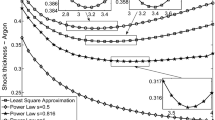Abstract
We present numerical simulations of a reacting shock–bubble interaction with detailed chemistry. The interaction between the Richtmyer-Meshkov instability and shock-induced ignition of a \( {\mathrm{H}}_2-{\mathrm{O}}_2 \) gas mixture is investigated. Shock wave Mach numbers in the range of \( Ma=2.13-2.50 \) at a constant initial pressure of \( {p}_0=0.50 \) atm trigger different reaction wave types. Deflagration is induced by a shock wave Mach number of \( Ma=2.13 \) and detonation by \( Ma=2.50 \). The spatial expansion of the bubble, the Richtmyer-Meshkov instability, and the subsequent Kelvin Helmholtz instabilities develop with a high reaction wave sensitivity. Mixing is significantly decreased by both reaction waves types, with detonation waves resulting in the strongest damping.
Access this chapter
Tax calculation will be finalised at checkout
Purchases are for personal use only
Similar content being viewed by others
References
Yang, J., Kubota, T., Zukoski, E.: Applications of shock-induced mixing to supersonic combustion. AIAA J. 31, 854–862 (1993)
Marble, F., Zukoski, E., Jacobs, J., Hendricks, G., Waitz, I.: Shock enhancement and control of hypersonic mixing and combustion. In: AIAA 26th Joint Propulsion Conference, Orlando (1990)
Brouillette, M.: The Richtmyer-Meshkov instabilty. Annu. Rev. Fluid Mech. 34, 445–468 (2002)
Ranjan, D., Oakley, J., Bonazza, R.: Shock-bubble interactions. Annu. Rev. Fluid Mech. 43(1), 117–140 (2011)
Haehn, N., Ranjan, D., Weber, C., Oakley, J., Rothamer, D., Bonazza, R.: Reacting shock bubble interaction. Combust. Flame 159(3), 1339–1350 (2012)
O’Conaire, M., Curran, H., Simm ie, J., Pitz, W., Westbrook, C.: A comprehensive modeling study of Hydrogen oxidation. Int. J. Chem. Kinet. 36, 603–622 (2004)
Strang, G.: On the construction and comparison of difference schemes. SIAM J. Numer. Anal. 5(3), 506–517 (1968)
Hu, X.Y., Tritschler, V.K., Pirozzoli, S., Adams, N.A.: Dispersion-dissipation condition for finite difference schemes. ArXiv e-prints (2012)
Gottlieb, S., Shu, C.W.: Total variation diminishing Runge-Kutta schemes. Math. Comput. 67, 73–85 (1998)
Brown, P.N., Byrne, G.D., Hindmarsh, A.C.: VODE: a variable-coefficient ODE solver. SIAM J. Sci. Stat. Comput. 10(5), 1038–1051 (1989)
Oran, E., Boris, J.: Numerical simulation of reactive flow. Cambridge University Press, Cambridge (2005)
Youngs, D.: Numerical simulation of mixing by Rayleigh-Taylor and Richtmyer-Meshkov instabilities. Laser Part Beam 12, 725–750 (1994)
Acknowledgments
The authors gratefully acknowledge the Gauss Centre for Supercomputing e.V. (www.gauss-centre.eu) for funding this project by providing computing time on the GCS Supercomputer SuperMUC at Leibniz Supercomputing Centre (LRZ, www.lrz.de).
Author information
Authors and Affiliations
Corresponding author
Editor information
Editors and Affiliations
Rights and permissions
Copyright information
© 2017 Springer International Publishing AG
About this paper
Cite this paper
Diegelmann, F., Tritschler, V., Hickel, S. (2017). Mach Number Influence on Ignition and Mixing Processes in a Reacting Shock–Bubble Interaction. In: Ben-Dor, G., Sadot, O., Igra, O. (eds) 30th International Symposium on Shock Waves 2. Springer, Cham. https://doi.org/10.1007/978-3-319-44866-4_57
Download citation
DOI: https://doi.org/10.1007/978-3-319-44866-4_57
Published:
Publisher Name: Springer, Cham
Print ISBN: 978-3-319-44864-0
Online ISBN: 978-3-319-44866-4
eBook Packages: EngineeringEngineering (R0)




